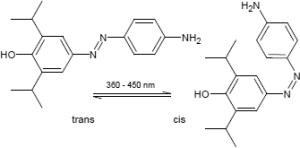
Inhibitory neurotransmitters dampen the activity of neurons. This regulatory effect forms the basis for the action of many anesthetics.
For example, propofol, a common anesthetic, interacts with receptors on neural cell membranes that normally bind the inhibitory neurotransmitter gamma-amino butyric acid (GABA).
Binding of GABA opens protein channels through which negatively charged chloride ions stream into the cell. By raising the resting electrical potential across the membrane, this makes the cell less likely to fire in response to an incoming stimulus.
Propofol magnifies this effect and this functions as an anesthetic.
Dirk Trauner, Professor of Chemical Biology and Genetics at LMU and a member of the Excellence Cluster CIPSM, is a specialist in the art of conferring on "blind" nerve cells the ability to react to light. Working with colleagues based in Switzerland and the US, he has now developed a derivative of propofol that allows the action of the GABA receptor to be regulated by light. "By attaching a molecular switch to propofol, we have obtained a light-sensitive molecule that is a more potent anesthetic than propofol itself, in the dark," Trauner explains.
Sleepless when the sun shines
In this case, light serves to largely inactivate the anesthetic effect of the compound, as the researchers were able to demonstrate in experiments on tadpoles. When exposed to a low concentration of the propofol derivative, the animals were anesthetized, as expected. However, when irradiated with violet light, they promptly revived, but remained active only as long as the light was on. In the dark, they were immobilized once again. The light-dependent effect is completely reversible, as the tadpoles recovered fully upon transfer to their normal aquarium.
The new agent could be used to treat certain forms of blindness, such as retinitis pigmentosa, which leads to loss of vision owing to progressive destruction of photoreceptors. However, neurons deeper in the retina are unaffected, and are accessible to ambient light. "The inner cells also bear GABA receptors on their surfaces, and in principle they could be turned into light-responsive cells with the help of the new compound, which would allow us to bypass the defective photoreceptors," says Trauner. He and his research group are now actively exploring this possibility. (Angewandte Chemie, see below)
(göd)
Further Information:
Marco Stein, Simon J. Middendorp, Valentina Carta, Ervin Pejo, Douglas E. Raines, Stuart A. Forman, Erwin Sigel, Dirk Trauner:
Azo-Propofols: Photochromic Potentiators of GABAA Receptors.
In: Angewandte Chemie International Edition; published online: 11 September 2012, DOI 10.1002/anie.201205475
Source: Ludwig Maximilians University, Munich, Germany
Last update: 13.09.2012
Perma link: https://www.internetchemistry.com/news/2012/sep12/azo-propofols.php
More chemistry: index | chemicals | lab equipment | job vacancies | sitemap
Internetchemistry: home | about | contact | imprint | privacy
© 1996 - 2023 Internetchemistry
